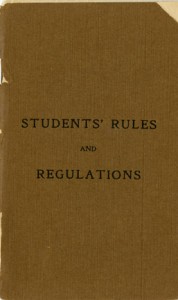In 1906, the University published its first Students’ Rules and Regulations. As promised by then-OSU President William Oxley Thompson, revisions were made from time to time and reveal an ever-changing campus. The following excerpts reflect some of the more notable inclusions
Intelligence Tests
Beginning with the academic year 1920-21 all students entering the University are required to take an intelligence test under the direction of the Department of Psychology.
Students’ Rules and Regulations, 1920
Living Arrangements
All undergraduate women students, not living with their parents or guardians, are required to secure their rooms through the Office of the Dean of Women. Those Sophomores, Juniors, and Seniors, who are sorority members are allowed to live in their chapter houses. Other students live in dormitories and approved houses.
Students’ Rules and Regulations, 1929
Regulations Governing Student Social Events
The following rules for the regulation of student social events have been passed by the Council on Student Affairs:
(1) All student dances must close at 12:00 midnight except as noted below. Girls must register in at 12:45.
(2) Only two one o’clock parties may be held during any academic year by each social group.
(3) To maintain uniformity, all house dances are to close at 12:00.
(4) Combinations of groups will be regarded as so many individual parties.
(5) Permission for any two o’clock parties must be obtained from the Council on Student Affairs. (This is expected to care for the Homecoming, Junior Prom, etc.)
(6) All parties must be held within the limits of Franklin County.
Students’ Rules and Regulations, 1936
Use of University Rooms
No rehearsal rooms will be available on Sundays, whether for music or dramatics.
No assembly rooms for motion pictures, lectures, or discussions unless it be of religious nature will be available on Sundays.
Students’ Rules and Regulations, 1952
The Use of Loudspeakers
Loudspeakers, either moving or stationary, can be used for advertising on campus only from 11:48 a.m. to 12:00 noon and from 12:48 p.m. to 1:00 p.m.
Students’ Rules and Regulations, 1960
Drinking and Possession of Alcoholic Beverages
Alcoholic beverages in any form shall not be permitted nor possessed on University property nor in University living units nor on the premises. This shall include all University Residence Halls without exception, all social fraternity and sorority houses without exception, and off-campus and/or undergraduate residences of all types including rooming houses and apartments except for student living off campus in categories as follows:
- Commuting students who reside with their parents or guardians.
- Married students who reside in their own homes, single or multiple living units or apartments, but not in rooming houses where students under age 21 reside.
- Students, age 21 or over, who reside in their own homes, single or multiple living unites or apartments, but not in rooming houses where students under 21 years of age reside.
Students’ Rules and Regulations, 1968











Recent Comments